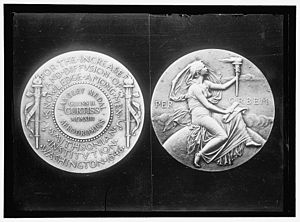From Wikipedia, the free encyclopedia
The
Langley Gold Medal
, or
Samuel P. Langley Medal for Aerodromics
, is an award given by the
Smithsonian Institution
for outstanding contributions to the sciences of
aeronautics
and
astronautics
. Named in honor of
Samuel P. Langley
, the Smithsonian's third Secretary, it was authorized by the Board of Regents in 1909.
[1]
The medal was suggested by
Alexander Graham Bell
. It is awarded for "meritorious investigations in connection with the science of aerodromics and its application to aviation".
[2]
List of award winners
[
edit
]
 Face and obverse of the 1913 Langley Medal awarded to Glenn Hammond Curtiss
Face and obverse of the 1913 Langley Medal awarded to Glenn Hammond Curtiss
(Reference unless given individually
[1]
)
See also
[
edit
]
References
[
edit
]
|
|---|
| Museums
| |
|---|
| Zoo
| |
|---|
| Research
| |
|---|
| Cultural
| |
|---|
| Education
| |
|---|
| Media
| |
|---|
| Awards
| |
|---|
| Other
| |
|---|